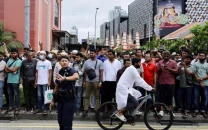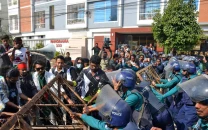Policing Afghanistan’s internally displaced
The new Afghan IDP policy gives some hope that more people will be given the protection they deserve.

The writer is a London-based independent researcher and analyst focusing on migration issues and the nexus between forced migration and security, principally in Afghanistan and Pakistan. She tweets @atnussan
In a welcome move, the Afghan Ministry of Refugees and Repatriations has taken the crucial step of launching a new national policy aimed at the protection of over 600,000 internally displaced Afghans. The policy has been hailed as a milestone since it provides new measures grounded on principles of domestic law, international human rights and humanitarian laws. Recognising fundamental rights like that of freedom of movement and residence enshrined in the Afghan Constitution, the new policy signals a fundamental shift in official attitudes towards the internally displaced.
Until now, Afghan IDPs have suffered disproportionately not only because of the dire situation inherent to displacement, but also because their plight was met by a reluctant government mainly with short-term responses. The government’s incapability of providing for long-term solutions was partly driven by a fear that supporting the integration of IDPs in their new settlements would compromise their return to their places of origin. Similarly, a fear that allowing IDPs to settle and integrate in their place of choice would eventually lead to the arrival of more IDPs. Integration was rarely considered a real option.
International organisations operating in Afghanistan too, have been caught in short-term approaches rather than in the provision of durable solutions. As noted by the Afghan Analyst Network, until now Afghan IDPs were not part of any specific international agency’s mandate and the responsibility to assist and protect them was shared among UN agencies, NGOs and the Afghan government. Without a specific body responsible for IDPs, most of the assistance has been that of emergency without any framework addressing displacement-specific vulnerabilities.
A new report published by the Internally Displaced Monitoring Centre and the Norwegian Refugee Council highlights the extent to which internally displaced Afghans and returnees residing in the largest urban areas have been affected by serious violations of internationally recognised human rights. In particular, the report focuses on forced evictions from government and privately owned land, stating that over 57,000 individuals have been affected by such threats. Post-2001 land distribution has been one of the most contentious issues for returnees and IDPs.
The UNHCR also notes that the new policy recognises that the government has fundamental duties “to prevent conditions leading to displacement, to minimise unavoidable displacement, as well as to mitigate and resolve its adverse effects without delay”. Under this policy, IDPs will be no longer either encouraged or forced to return to their place of origin.
The withdrawal of international forces will inevitably have security implications and the level of armed conflict is predicted to rise in several parts of the country. According to Khalid Koser at the Brooking Institution, future scenarios are unlikely to see large numbers of Afghans crossing borders either in Pakistan or Iran as has happened in the past. For the hundreds of thousands of Afghan returnees, who in the last decades started a new life in Afghanistan, it is improbable that they leave their homes again partly because of the increasingly restrictive policies adopted by neighbouring countries in recent years; for many the only option will be fleeing within Afghanistan. Current trends of internal displacement show that Afghans –– whether they flee armed conflict or escape environmental disasters –– tend to move towards large cities, posing enormous challenges both for protection and for urban planning and management. The combination of the two could easily become a major security concern if not addressed.
In light of such future scenarios, the new IDP policy gives some hope that more people will be given the protection they deserve. However, although UN agencies and other international organisations reiterated their support to the Afghan government, it remains to be seen how an operational plan will be developed and implemented.
Published in The Express Tribune, March 25th, 2014.
Like Opinion & Editorial on Facebook, follow @ETOpEd on Twitter to receive all updates on all our daily pieces.



















COMMENTS
Comments are moderated and generally will be posted if they are on-topic and not abusive.
For more information, please see our Comments FAQ